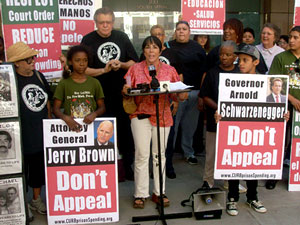CHARLENEM

LOS ANGELES (FinalCall.com) – “The reality will remain in this state that we tolerate death. We are only tolerating the deaths of the very poor, of the people of color, of the people in prison, but we are tolerating that in order to meet the needs of profit and a false need of a sense of public safety!”
With this declaration at an August 27 press conference in front of the Ronald Reagan Building in Downtown Los Angeles, Geri Silva, Executive Director of Families to Amend California’s Three Strikes Law (FACTS) urged Attorney General Jerry Brown to accept a federal three-judge panel’s decision, ordering California to develop a plan that would reduce the number of prisoners by 44,000 and address horrific conditions within State prisons over the next two years.
The State must produce its plan by September 18.
At press time, Abraham, a representative in Atty. Gen. Brown’s office, said he did not know whether he had decided to accept the court’s order or appeal it but would have his press secretary contact The Final Call.
The ruling is the latest step in a lawsuit filed by prison inmates over poor health care and overcrowding within California prisons.
The press conference was part of a state-wide action by about a dozen organizations, which personally delivered an open letter to the Attorney General, urging him to accept the prison reduction order.
The action was spearheaded by Californians United for a Responsible Budget (CURB), and the letter was endorsed by 63 organizations, including FACTS, the American Civil Liberties Union of Southern California, Critical Resistance (L.A. and Oakland), Drug Policy Alliance, Project Cry No More and Cease Fire (Vickey Lindsey), Education Not Incarceration Committee, Youth Justice Coalition, California Prison Focus, and the Bay Area Black Radical Congress.
The coalition insisted that although California’s prison budget has increased fivefold since 1994, that has not made its citizens safer. “Furthermore, the prison population has grown by 700 percent the majority of whom are Black and Latino, with one of the highest recidivism rates of 70 percent,” the organizations wrote.
The National Council on Crime and Delinquency (NCCD), a non-profit criminal justice research organization, conducted a nationwide study, which found that early release programs do not jeopardize public safety. CURB is using the study in its battle for prison reduction.
In its report, “The Case For Shorter Prison Terms: The Illinois Experience (released July 1994) the NCCD found that two programs, designed to control prison population growth, public safety, recidivism rates, and costs, performed well.
The programs reduced Illinois’ prison costs by $100 million, showed no significant decrease or increase in the state’s crime rate that could be linked to early release of prisoners or shorter prison terms.
CURB argued that in addition to alleviating prison overcrowding and inhumane conditions, it would free up funding for education, healthcare, employment and job training. It would also reduce chances for more prison riots, such as the recent melee at the California Institute for Men in Chino, Ms. Silva said.
On August 8, eight inmates at the prison’s Reception Center West Facility (which holds 1,300 inmates) began fighting. In the end, 55 inmates were transported to a local hospital for treatment, and the dormitory itself was burned down during the incident, the California Department of Corrections and Rehabilitation indicated.
According to prison officials, the riots stemmed from a fight between Black and Latino inmates, however, prison watch groups say the problem is undeniably prison overcrowding.
“If we’re concerned about California’s future, then why are we dragging our feet to implement the prison population cap, while cutting billions from public education, public assistance, and health care programs? Releasing elderly and infirm prisoners is a step in the right direction, but cutting $9 billion from public education is an outrage,” said Bob Lane of Critical Resistance.












